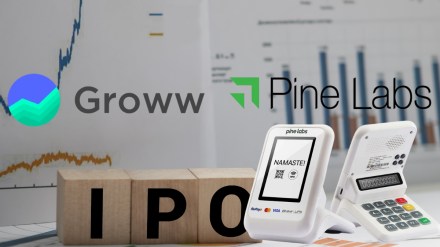Two IPOs that are definitely on your radar at the moment are the Groww IPO, which has been launched and the upcoming Pine Labs IPO. Both IPOs together are set to raise approximately Rs 10,500 crore from the primary markets. Both issues are a mix of fresh shares as well as offer for sale. However, if you are confused about which one to apply to, here is a quick comparison of the various aspects of the two IPOs.
Groww IPO Vs Pine Labs IPO: Issue details
Groww aims to raise Rs 6,632.30 crores from the primary markets. The issue is a combination of 10.60 crore fresh shares aggregating to Rs 1,060 crores and an offer for sale of 55.72 crore shares totalling Rs 5,572.30 crores.
The IPO opened for subscription on November 4 and will close on November 7. The allotment is expected to be finalised on November 10, while the listing on the exchanges, NSE and BSE, is likely to be on November 12.
In comparison, Pine Labs will mop up Rs 3,899.91 crores through a mix of 9.41 crore fresh shares, aggregating to Rs 2,080 crores, and an offer for sale of 8.23 crore shares amounting to Rs 1,819.91 crores.
The company will open the bidding window on November 07 and close it on November 11. The allotment of shares is estimated to be finalised on November 12. The listing of shares on BSE and NSE is expected to be on November 14, as per the tentative schedule.
Groww IPO Vs Pine Labs IPO: GMP
The Groww IPO has been fetching a premium of 17.3% in the grey market, surging to the highest level in the past five days.
The Pine Labs IPO is also seeing similar premium levels even before the issue opened for subscription. Its GMP is up close to 16% in the grey market. The GMP remained steady for the second consecutive day.
However, investors should be aware that the grey market is an unofficial place where shares trade illegally.
Groww IPO Vs Pine Labs IPO: Business fundamentals
Billionbrains Garage Ventures (BGVL), operating under the brand Groww, is a direct-to-customer digital investment platform offering wealth creation opportunities across equities, derivatives, bonds, and mutual funds. Customers can also access margin trading and personal loans through its proprietary, in-house technology platform.
Groww commands a market share of almost 26% in net new demat account additions and 18.5% in active SIPs as of June 2025. The company is India’s largest and fastest-growing investment platform by active NSE users, being the only Indian investment app to surpass 100 million cumulative downloads.
Meanwhile, Pine Labs is a leading Indian merchant commerce platform that provides point-of-sale (POS) solutions, payment processing, and merchant financing services. The company empowers businesses of all sizes, from small retailers to large enterprises, with digital payment technologies and value-added services.
The company had 988,304 merchants, 716 consumer brands and enterprises, and 177 financial institutions, as of June 2025. Pine Labs has served top consumer brands, including Amazon Pay, LG Electronics, Flipkart Internet, and Redington. Under the financial institutions, its key customer base includes HDFC Bank, Axis Bank, and ICICI Bank.
Groww IPO Vs Pine Labs IPO: Expert take
Let’s take a look at how experts are rating both these IPOs –
Highlighting the Groww valuations, Angel One pointed out, “at the upper price band of Rs 100 per share, the company is valued at a post-issue P/E of 40.79x. The valuation appears steep compared to peers. So we assign a ‘Neutral’ rating for investors with a long-term perspective.” Most others have rated the IPO a ‘Subscribe’ for the long-term.
For the Pine Labs IPO too, brokerages have rated it as ‘Subscribe’. According to SBI Securities, “On the back of a robust business model, going forward, we believe the company is well placed to deliver profitable growth and hence, we recommend investors to ‘Subscribe’ to the issue with a long-term investment horizon. Furthermore, the company plans to repay debt of Rs 532 crore through the proceeds from the IPO. The company’s operations have witnessed a turnaround with robust growth in EBITDA and adj EBITDA during the FY23-FY25 period.”
